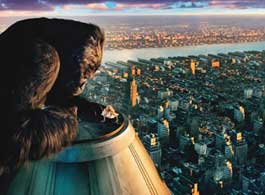home | metro silicon valley index | movies | current reviews | film review

Photograph by Weta Digital/Universal Studios
Gotham Gorilla: King Kong surveys his new kingdom in Peter Jackson's blockbuster.
Big Fella
'King Kong': Beauty kills the beast, but beauty makes him alive, too.
By Richard von Busack
HERE IS A story that comes back again at different dark times: in 1933 and 1976 and now. The multiple meaning of the parable depends—like all great parables—on individual interpretation: Beauty destroys us. Man is vile. As Robert Warshow wrote, regarding gangster movies: "The final meaning of the city is anonymity and death," a fatal drop from penthouse to pavement.
Peter Jackson's version of King Kong is engineered as the biggest movie of all time. The machinery shows, and sometimes creaks—elements of Titanic and Jurassic Park double the length of the original. A brontosaurus stampede through a narrow canyon, with some indifferent patches of animation, are meant to link to the inevitable video game. (No matter how many tickets Kong sells, the game will sell more; if this movie is sour about showbiz, maybe that's because there were so many commercial needs this movie was made to serve.)
Jackson's scope makes this version different than the predecessors. The difference isn't just in the Skull Island that's roiling with dinosaurs and indescribably loathsome gargantuan insects. It isn't just in the exquisitely detailed New York of 1933, with cityscapes that can be peered into for block after block. And not even in the finale, against a dawn-lit winter horizon, where Kong makes his last stand. Jackson and his co-writers (the same who worked on his Lord of the Rings trilogy) took care of the tale where it counts: the love story.
The story's central problem is what might draw a very large silverback gorilla and a lonely vaudeville performer together. It's her sense of tragedy: when Carl Denham (Jack Black, suitably diabolical) outlines a vague scenario of a woman who can't submit to love, the leading lady responds. She immediately understands the Ibsen in Denham's bare, silly outline. I've said it before, but the best computer effects are nothing but cream-cheese without actors to make them live. In Naomi Watts' Ann Darrow, the odd, yet believable connection between the lady and the ape is virtually without dialogue, leaving the relationship not put into so many words. My classic Kong-loving friend Mike Monahan worried that Jackson would repeat the mistake of the 1976 version: turning the creature into a pet, changing a symbol of indomitable solitude into, basically, a big misbehaving dog.
It's the other way around in Jackson's Kong—she is his pet. When he is recovering from his wounds, Watts' Ann does the only thing she knows how to do as a performer: She dances for him, she juggles, she's the court jester to this great king with his suffering eyes. Watts is the most childlike of actresses. She's naturally, limpidly youthful. It's a later moment—a sort of ballet between Ann and Kong on an icy lake in Central Park—that make this a classic.
Jackson's interpretation reflects the way our feelings about great apes have changed over the decades. When one catches the gaze of a gorilla at the zoo, there's always a feeling of honor at being in the presence of the rare animal, seeing the tragic beauty and the wrongness of its captivity. And Jackson responds to this wrongness. It's the child in him, just like it's the child in Watts, that makes this movie such a thing of beauty.
![]() King Kong (PG-13, 187 min.), directed by Peter Jackson, written by Fran Walsh, Philippa Boyens and Peter Jackson, based on the story by Merian C. Cooper and Edgar Wallace and starring Naomi Watts and Jack Black, plays valleywide.
King Kong (PG-13, 187 min.), directed by Peter Jackson, written by Fran Walsh, Philippa Boyens and Peter Jackson, based on the story by Merian C. Cooper and Edgar Wallace and starring Naomi Watts and Jack Black, plays valleywide.
Send a letter to the editor about this story.